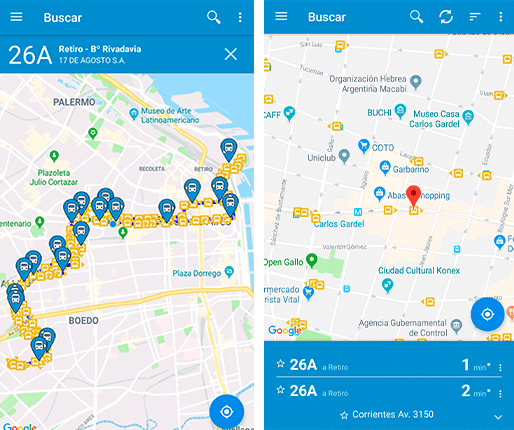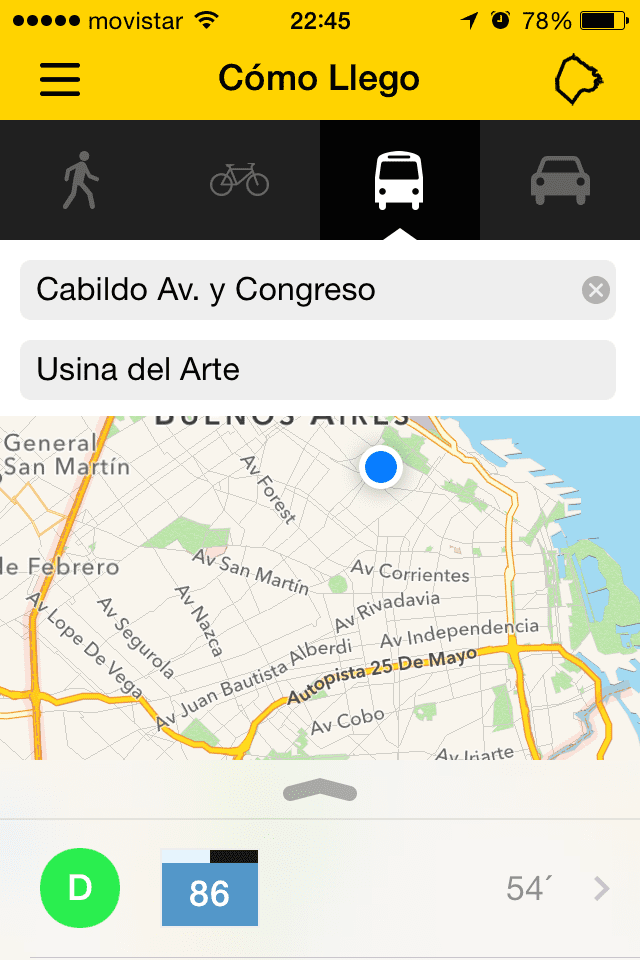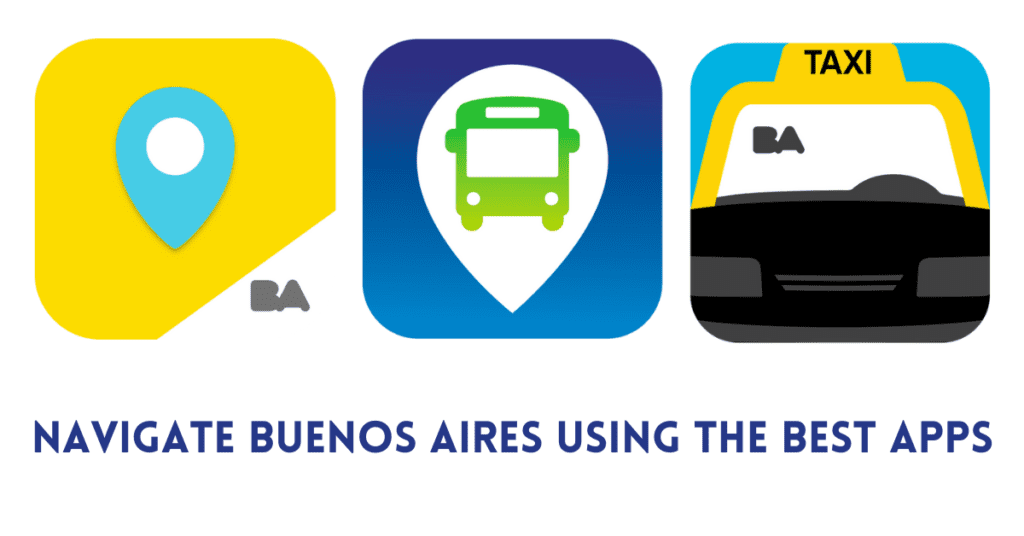This article covers all you need to know about local travel apps for getting around in Buenos Aires. Gone are the days of City Mapper and Lyft; now, the city’s official transportation apps are the way to go. Use our nifty guide to learn how to use them and what they can offer.
By Carla Chinski, Content Marketing Director and Content Creator for Vamos Academy
If you’re on a budget, or just want to get around using public transportation in Buenos Aires, your usual transport apps won’t cut it. Luckily, taking a bus, renting a bike or using the subway in Argentina is way easier if you are up to speed on all the apps locals are using. We’ll show you how to learn your way around in no time with this updated list.
Also Read: How to Use Uber in Argentina
While travelling or visiting someplace new, what’s the first thing that pops into your head? If you’re thinking that question is “Where’s the bathroom?”, you’re not that mistaken. Knowing how to go from one place to the next can turn a hum-drum trip into an incredible experience. In-city travelling gives you the tools to live and breathe the places you meet. How about getting to that niche pasta restaurant in the outskirts of the city? Or maybe you just want to get some of that city buzz.
Language is not the only barrier to using Argentine apps (for which there is a pretty straightforward solution). We’ll also give you some savvy tips on how to use the apps to their full advantage. Or, for example, how to know via the apps whether to ride the subway or take the bus during rush hour. Don’t forget you can download the apps on your favorite app store for your phone’s OS. Here are the most popular ones to get you started on your Buenos Aires journey.

Cuándo SUBO: Tracking Buses in Real-time
According to the official government website, this app stores information on more than 200 buses in the City of Buenos Aires and Greater Buenos Aires. Today, Cuándo SUBO is the only local app that lets you see where a bus is in real time. Although since the advent of the Metrobus–the optimization of Buenos Aires’ bus and bike lines and routes–the government has provided LED signs where you can see which bus is closest, the signs often break down or are not there at all (sigh).

You don’t need to log in to use the app, which is a nice feature these days. The app will automatically store your transport-related information so you can easily access it anytime. What’s even better, you don’t need to know that much Spanish to understand what’s going on.
Nearby stops are marked on a Google Maps-like interactive map. When you click on one of them, you’ll know how much longer you’ll have to wait for the bus or subway. And here’s the best part: if you click on the estimated waiting time, you’ll be taken to another page, where you’ll be able to see where the bus is currently located. You can ignore the list that will be displayed below, with all the stops in between your current location and that of the bus.
Other functionalities include: adding a stop to favorites, accessing your most recent searches and stops and set a reminder.
Cómo Llego: Great for seeing subway, trains and bus stops
Cómo Llego is a bit more “rustic”, if you will, as it has less features and it can lag at times. But it’s still a very good option, mainly because it seems to have better information on which public transportation is more effective, cost-wise and time-wise, than Google Maps does. One thing that makes the app stand out is that is has real time information on which subway or bus lines aren’t working that day. That way, you can avoid being unpleasantly surprised (strikes, anyone?)
The app also has the same features as the website version, just FYI in case you want to access it from another device. Within the app, recent searches are also visible. Using the yellow, two-way arrows on the top right-hand corner of the screen, you can turn your starting point into your destination and viceversa or type a new address in. Unfortunately, the app doesn’t recognize almost any addresses if you input, for example, “Museo MALBA”. You must type in the street name and number; you can also use the street intersection (a handy feature for Argentines, who love to say: “let’s meet at Callao and Corrientes!”.)
Once you type that in, the map you’ll then see is pretty static, except for the feature to track your journey via GPS in (somewhat) real time. Once you get to the map, you’ll have the option to choose your means of transportation: riding a bus, riding a bike or walking. The scrollable bottom half will show bus frequency (low-medium-high). You’ll be able to see a breakdown of the trip into parts, from walking to the bus stop to getting off the bus and to your final destination.

Google Maps: The most accurate bus times predictions app
Use Google Maps to your international advantage. Maybe it’s a bit of an obvious choice, but keep in mind that Maps’ suggested routes and means of travel are often faulty. However, Google Maps has something going for it: in our experience, it’s the only app that perfectly predicts bus arrival time, even though, unlike Cuándo SUBO, you cannot check where the bus is in real time.
The main benefit of using Google Maps is its ability to recognize spots by their given name, so to speak, and not the exact address nor the intersection. It might surprise you to know that most locals do not use Maps. But it has all the benefits of a smooth google interface, a nice user experience, and a comfortable design.
A bit more about this topic:
SUBE SUBTE CARD
Before we go any further, first things first, make sure that you purchase a Subte card before trying to get onto the Subte or take a colectivo (bus). Otherwise your journey will not be very successful. Ironically, you cannot purchase them at any Subte stations, but Subte cards can be bought from various kiosks. You can check the locations that sell the SUBE in Google Maps, inputing “Sube” in the search bar . Luckily, they are much easier to top up than to purchase. Most kioscos, lottery shops and subway stations all have machines available.
SUBTE (SUBWAY)
The Subte (underground train) network is great for getting around the inner city. During peak hours it can get really busy, so take the time to check out the Cómo Llego site mentioned earlier in this article to see which subte lines get you to which neighborhoods. There are also updates on delays, costs of tickets and the hours of service.
The site is at: http://www.buenosaires.gob.ar/subte
COLECTIVOS
Once you have mastered the subte, the next step up the public transport scale is the colectivos, or buses. Colectivos will get you more or less anywhere in Buenos Aires, including La Boca, Recoleta and even out to the Tigre Delta. You are going to have to practice your Spanish Buenos Aires-style a little when communicating with the driver, but to make sure you are probably on the right bus line first check this website. You simply put in where you are and where you want to go and it will give you over half a dozen different options. It is one of my personal favourites for figuring out how to get anywhere within Capital Federal.
MOOVIT
Now wouldn’t it just be perfect if you could work out which is the best route for you to get to your destination and compare. Well, Moovit is your godsend. Moovit does all the work for you, think of it as a better and more precise Google Maps. You type in where you are and where you want to go and the app will display the routes you can take. Moovit provides information on the means of transport, the time it takes to get to your location, and the precise details regarding which bus to take and which stop to get off, among other useful info. It’s simple and effective; definitely the easiest way to navigate your way around the city.
TAXIS
If public transport is too time-consuming and you want to enjoy the air conditioned comfort of a taxi check out the BA Taxi app, which you can download from any app store. It is simple to use and gives you the approximate cost of a taxi ride anywhere in the city, as well as a guide to the quickest route the driver should take. No more driving around in circles if you are a short-term traveller to Buenos Aires. You will be provided with an estimated fee, as well as the general route the cab should take. A word of warning: if you do end up taking a taxi, make sure to get in a “radio cab”. Those are the taxis with the prism sign on their roof, usually stating their company name. As these companies are linked to a company, their rides are tracked, and so the drivers are way less likely to take you on an obscure or long-winded route.
UBER
There is a lot of drama currently surrounding Uber at the moment in Buenos Aires. Leaving many people confused as to whether the app is legal or not. Well the short end of the story is technically no but it is legal for you to use. The Argentinian Government is trying to prevent it, while under huge pressure from the taxi companies. However, Uber claim the Government has no legal ground. If you have ever checked out the app while in Buenos Aires, you will see that it’s functioning perfectly. While taxi drivers may hate it for obvious reasons (Uber is most likely taking away most of their clientele), people here love it. It is probably the safest mode of transport and the easiest.
While on the whole it may be cheaper and easier than getting a taxi, do remember during peaks in demand the surcharge will result in a fee way higher than that of a taxi’s. Another recommendation for Uber: use it to go to and from the airport. Again, however, be sure to check out what surcharge before you take one, so you don’t get any nasty surprises.






